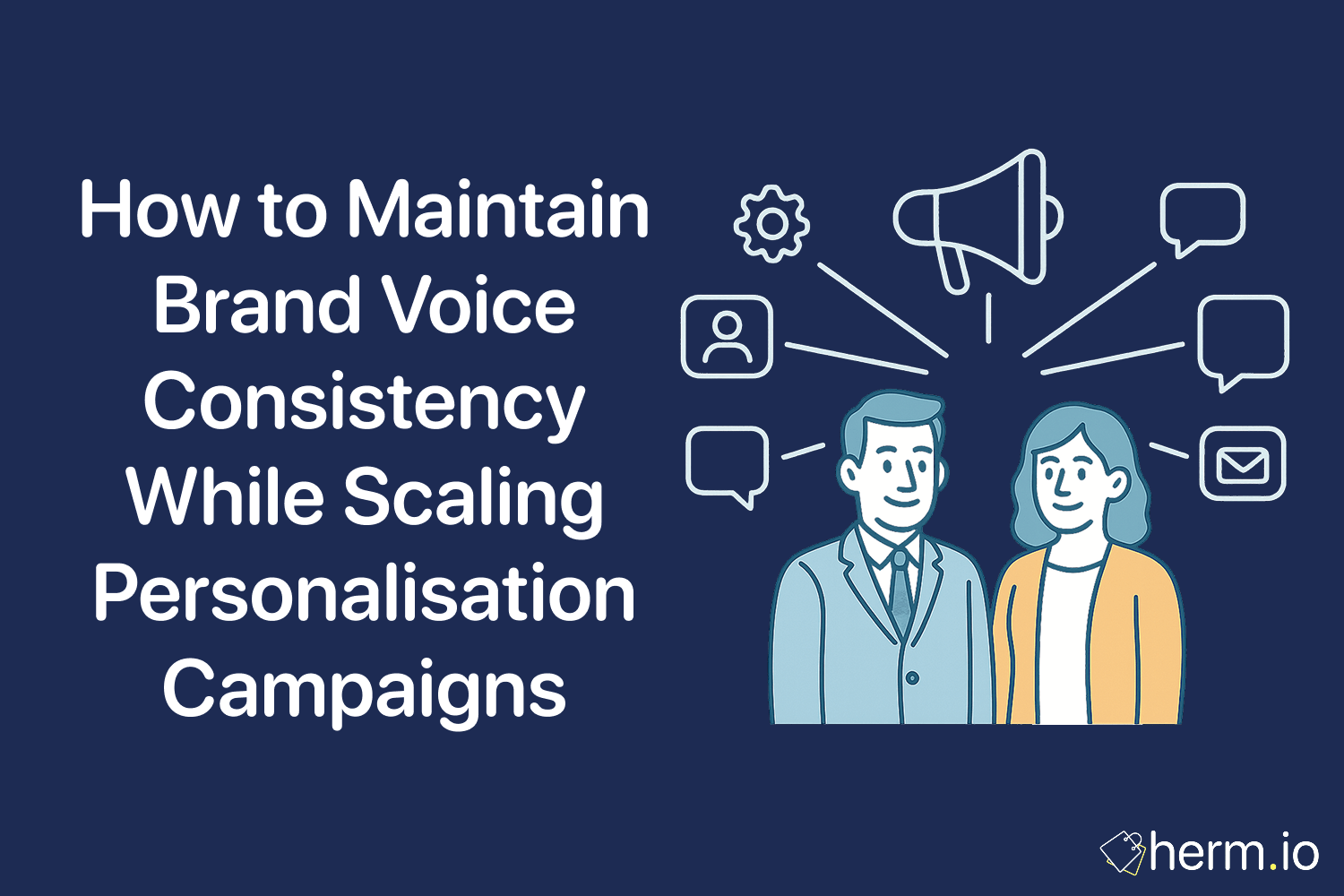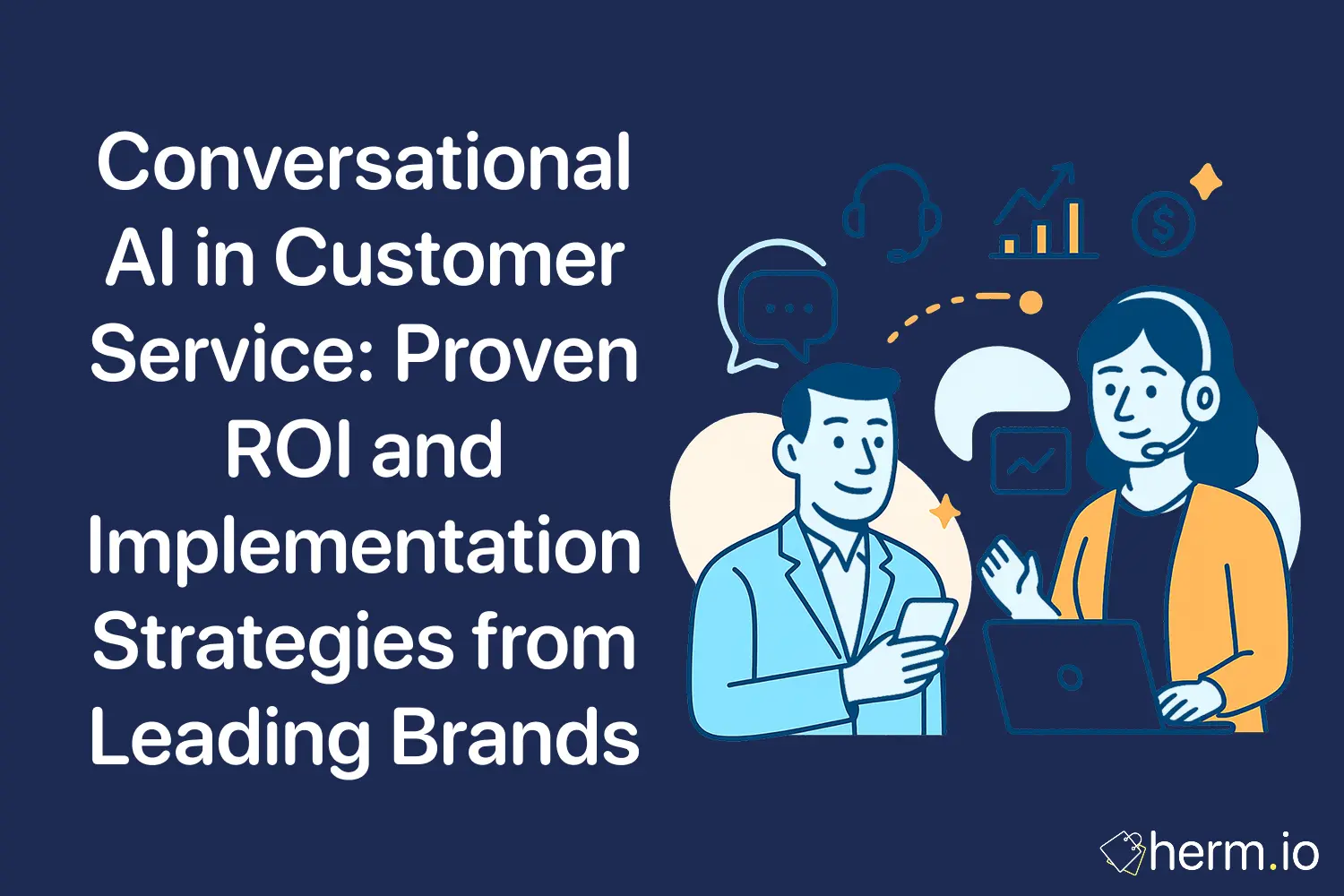
Here's what actually works: the brands that master personalisation without losing their voice treat consistency as a strategic advantage, not a creative constraint. I've watched countless marketing teams struggle with this balance—creating highly targeted campaigns that somehow feel disconnected from their core brand identity.
The challenge isn't choosing between relevance and recognition; it's building systems that deliver both simultaneously. When you get this right, personalisation amplifies your brand voice rather than diluting it. When you get it wrong, you end up with fragmented messaging that confuses customers and undermines performance.
This comprehensive guide breaks down exactly how successful brands maintain voice consistency whilst scaling personalised experiences. You'll discover practical frameworks, examine verified case studies across industries, and learn implementation strategies that protect brand equity while driving measurable results.
The Real Cost of Voice Inconsistency in Personalised Campaigns
Understanding the Performance Impact
Let's cut through the noise and focus on what actually happens when personalisation conflicts with brand voice. The data reveals three critical failure points that directly impact your bottom line.
Reduced Brand Recognition Across Touchpoints
When your personalisation engine generates content that sounds different from your established voice, customers struggle to connect experiences back to your brand. Think of this like meeting someone who speaks differently every time you encounter them—the relationship never solidifies because recognition remains incomplete.
Research conducted by the Marketing Science Institute demonstrates that consistent brand voice increases recognition by 23% across digital touchpoints. More importantly, this recognition directly correlates with purchase intent and customer lifetime value.
Cognitive Load and Decision Fatigue
Inconsistent messaging creates what behavioural psychologists call "cognitive load"—the mental effort required to process conflicting information. When your social media voice differs dramatically from your email automation tone, subscribers must work harder to understand your value proposition.
This additional processing time typically results in one of two outcomes: immediate abandonment or delayed decision-making. Both scenarios reduce conversion rates and extend sales cycles unnecessarily.
Erosion of Trust and Authority
Perhaps most critically, voice inconsistency signals internal confusion to your audience. If you can't maintain consistent communication about your own products and services, why should customers trust you to solve their problems consistently?
The compound effect becomes particularly evident in customer service interactions, where voice misalignment between marketing touchpoints and support conversations creates friction that's difficult to repair.
Fundamental Framework: Core Voice vs. Dynamic Content
The Architecture of Scalable Voice Consistency
The most successful personalisation programmes separate their brand communication into two distinct layers: immutable core elements and flexible personalisation variables. This architectural approach prevents voice dilution while enabling sophisticated targeting.
Core Voice Elements (Non-Negotiable)
Your core voice encompasses the fundamental personality traits that define how your brand communicates across all contexts. These elements remain constant regardless of audience segment, channel, or personalisation trigger.
Primary voice characteristics include your brand's emotional register (formal vs. conversational), authority level (expert vs. peer), and communication style (direct vs. narrative). Additionally, signature phrases, value propositions, and key messaging pillars belong in this protected category.
For implementation purposes, core elements should be stored as locked templates in your content management system. This prevents well-intentioned team members from making modifications that gradually shift your brand voice over time.
Dynamic Personalisation Variables (Flexible)
Dynamic elements include product recommendations, geographic references, behavioural triggers, and demographic adaptations. These components can change based on user data while maintaining the core voice characteristics.
The key principle here involves treating personalisation as content that flows through your brand voice, rather than content that replaces it. Your voice becomes the consistent vessel that delivers personalised information, ensuring recognition remains strong regardless of the specific message.
Implementation Hierarchy
Establish a clear hierarchy where core voice elements always take precedence over personalisation preferences. When conflicts arise between voice consistency and personalisation relevance, your system should default to maintaining voice integrity while finding alternative ways to deliver personalised value.
Case Study Analysis: Brands Executing Voice-Consistent Personalisation
Spotify: Maintaining Playful Authority Across Personalised Experiences
Spotify's personalisation strategy demonstrates how algorithmic content generation can reinforce rather than replace brand voice. Their "Discover Weekly" and "Release Radar" features deliver highly individualised music recommendations while maintaining the brand's characteristic blend of music expertise and approachable enthusiasm.
The implementation approach centres on consistent copywriting frameworks that adapt to individual user data. Instead of generating entirely new voice patterns for each user, Spotify applies their established tone to personalised contexts. For example, playlist descriptions maintain their trademark clever wordplay while incorporating user-specific listening patterns.
Results from their 2019 annual report indicated that personalised playlists generated 40% higher engagement rates compared to editorial playlists, while brand recognition scores remained stable across all user segments. This demonstrates that voice consistency and personalisation relevance can reinforce each other when properly structured.
Netflix: Storytelling Voice Across Dynamic Recommendations
Netflix maintains their narrative-driven brand voice while delivering personalised content recommendations through sophisticated copy adaptation systems. Their approach involves creating modular content blocks that combine core brand messaging with individual viewing data.
The streaming service uses what they term "voice-consistent variables"—personalisation elements that slot into predetermined brand voice frameworks. Recommendation descriptions follow established narrative patterns while incorporating user-specific viewing history and preferences.
Performance data from their technology blog reveals that voice-consistent personalisation increased click-through rates by 35% compared to generic algorithmic descriptions. More significantly, customer satisfaction surveys showed improved brand perception scores when personalised recommendations maintained Netflix's distinctive storytelling approach.
Sephora: Beauty Expertise Voice in Personalised Product Advice
Sephora's Beauty Insider programme exemplifies how expertise-driven brands can personalise recommendations without compromising authority. Their approach involves training personalisation algorithms to generate content that sounds like it comes from knowledgeable beauty consultants rather than automated systems.
The beauty retailer's implementation strategy focuses on what they call "expert voice templates"—content structures that maintain professional beauty advice tone while adapting to individual skin concerns, preferences, and purchase history. Product recommendations include educational context that reinforces Sephora's position as a beauty authority.
Data from their customer experience team shows that voice-consistent personalised recommendations generate 60% higher conversion rates compared to standard algorithmic suggestions. Additionally, customer lifetime value increased by 25% among Beauty Insider members who regularly engaged with personalised content that maintained the brand's expert voice.
ASOS: Fashion-Forward Voice in Dynamic Product Discovery
ASOS successfully scales their trend-conscious brand voice across personalised shopping experiences by treating voice consistency as a competitive differentiator. Their personalisation engine generates product descriptions and styling advice that maintains the brand's fashion-forward enthusiasm while adapting to individual style preferences.
The fashion retailer's approach involves creating voice-guided algorithms that prioritise brand-appropriate language patterns over generic e-commerce copy. Product recommendations include styling context and trend information that reinforces ASOS's position as a fashion authority for their target demographic.
Performance metrics from their digital transformation report indicate that voice-consistent personalisation increased average order value by 45% and reduced return rates by 18%. Customer feedback consistently highlighted the authentic feel of personalised recommendations compared to competitors' more generic approaches.
Booking.com: Helpful Authority in Travel Personalisation
Booking.com demonstrates how service-oriented brands can maintain helpful, authoritative voice while delivering personalised travel recommendations. Their approach centres on what they term "helpful personalisation"—content that provides genuine value while maintaining the brand's trustworthy, knowledgeable tone.
The travel platform's implementation strategy involves training their recommendation systems to generate content that sounds like advice from experienced travel consultants. Personalised suggestions include practical context and local insights that reinforce Booking.com's expertise while addressing individual travel preferences and constraints.
Data from their annual sustainability and travel report shows that voice-consistent personalised recommendations increased booking conversion rates by 52% and improved customer satisfaction scores by 28%. The approach particularly resonated with business travellers who valued the combination of personalisation and authoritative travel guidance.
Strategic Implementation: Building Voice-Consistent Personalisation Systems
Content Architecture and Template Strategy
Modular Content Framework
The most effective approach involves building modular content systems where core voice elements combine with personalisation variables through predetermined structures. This architecture ensures voice consistency while enabling sophisticated personalisation capabilities.
Start by identifying your brand's non-negotiable voice characteristics: specific word choices, sentence structures, emotional registers, and communication patterns that define your brand personality. Document these elements as content guidelines that govern all personalisation outputs.
Next, create template structures that accommodate personalisation variables without disrupting core voice elements. These templates should include locked sections (core voice content) and variable sections (personalised information) with clear guidelines for how personalisation data integrates with brand voice requirements.
Quality Assurance Protocols
Implement systematic quality checks that evaluate personalised content against voice consistency standards. This involves both automated screening tools and human review processes that catch voice deviations before content reaches customers.
Automated tools can flag obvious violations: inappropriate tone words, banned phrases, or structural patterns that conflict with your brand voice guidelines. However, human review remains essential for evaluating subtle voice consistency issues that automated systems might miss.
Content Governance Structure
Establish clear ownership and approval processes for personalisation content that crosses multiple teams. Voice consistency requires coordinated effort between brand teams (who define voice standards), marketing teams (who create personalisation strategies), and technology teams (who implement systems).
Create a centralised style guide that addresses personalisation-specific voice challenges: how to maintain brand tone in automated emails, what voice adaptations are acceptable for different audience segments, and how to handle voice consistency across multiple languages or regional variations.
Technology Integration and Automation
Voice-Aware Content Management Systems
Your content management system should actively support voice consistency rather than treating it as an afterthought. This requires technical architecture that prioritises brand voice compliance throughout the content creation and personalisation process.
Implement content templates with built-in voice guidelines, automated tone checking, and approval workflows that route personalised content through appropriate brand review processes. Your CMS should make voice-consistent personalisation easier than voice-inconsistent alternatives.
Algorithm Training for Voice Consistency
Modern personalisation algorithms can learn to maintain brand voice consistency when properly trained. This involves feeding your systems examples of voice-appropriate content and establishing success metrics that balance personalisation relevance with voice consistency requirements.
Work with your development team to create algorithm training datasets that include examples of voice-consistent personalised content alongside examples of voice violations. This training helps automated systems understand not just what content to recommend, but how to communicate recommendations in your brand's distinctive voice.
Performance Measurement and Optimisation
Establish metrics that track both personalisation effectiveness and voice consistency maintenance. Traditional personalisation metrics (click-through rates, conversion rates, engagement) should be evaluated alongside voice consistency indicators (brand recognition scores, voice compliance ratings, customer feedback themes).
Regular voice audits become essential as your personalisation programme scales. Monthly reviews should examine a representative sample of personalised content across all channels, evaluating voice consistency and identifying areas where systems might be drifting from brand standards.
Advanced Personalisation Strategies That Preserve Brand Voice
Contextual Voice Adaptation
Situational Voice Modulation
Advanced brands understand that voice consistency doesn't require identical communication across all contexts. Instead, they develop voice adaptation guidelines that maintain core brand personality while adjusting communication style based on customer situation and channel context.
For example, customer service personalisation might employ a more helpful, solution-focused version of your brand voice, while promotional personalisation emphasises excitement and urgency. Both variations maintain core voice characteristics while adapting to contextual requirements.
The key involves creating voice variation guidelines that specify acceptable adaptations for different contexts. These guidelines prevent voice drift while enabling appropriate contextual flexibility that improves customer experience.
Emotional Register Management
Sophisticated personalisation systems can adapt emotional register (formal vs. casual, energetic vs. calm) based on customer data while maintaining core brand voice characteristics. This approach recognises that effective communication requires emotional appropriateness alongside voice consistency.
Customer lifecycle stage, previous interaction history, and purchase context all provide valuable inputs for emotional register adaptation. New customers might receive more formal, informative communications, while loyal customers receive more casual, familiar messaging—all within your established brand voice framework.
Cross-Channel Voice Orchestration
Unified Voice Experience Architecture
The most successful personalisation programmes ensure voice consistency across all customer touchpoints: email, social media, website, mobile app, customer service, and offline interactions. This requires coordinated voice strategy that transcends individual channel optimisation.
Create channel-specific voice guidelines that address platform constraints while maintaining core brand voice consistency. Social media might employ shorter, more conversational versions of your brand voice, while email allows for more detailed, narrative-driven communications.
Voice Consistency in Customer Journey Mapping
Map your customer journey to identify voice consistency requirements and personalisation opportunities at each stage. Early awareness touchpoints might prioritise brand voice establishment, while later consideration stages can employ more sophisticated personalisation while maintaining voice recognition.
Consider how voice consistency supports customer progression through your funnel. Consistent voice creates familiarity that reduces friction, while personalisation demonstrates understanding that builds trust. The combination creates compound effects that improve overall customer experience.
Measuring Success: KPIs for Voice-Consistent Personalisation
Brand Voice Consistency Metrics
Voice Recognition Scoring
Implement systematic voice recognition testing where customers evaluate whether personalised content sounds like your brand. This qualitative feedback provides essential insights that complement quantitative engagement metrics.
Conduct monthly voice recognition surveys with representative customer samples, presenting personalised content alongside competitor examples and measuring recognition accuracy. Track trends over time to identify voice drift before it affects business performance.
Content Audit Compliance Rates
Establish regular content audits that evaluate personalised content against documented voice guidelines. Track compliance rates across channels, teams, and content types to identify areas requiring additional voice training or system improvements.
Create scoring rubrics that evaluate voice compliance across multiple dimensions: tone appropriateness, vocabulary consistency, structural alignment, and emotional register accuracy. Use these scores to guide voice improvement initiatives and team training programmes.
Business Performance Integration
Voice-Attributed Conversion Analysis
Develop attribution models that connect voice consistency with business outcomes. Compare performance metrics between voice-compliant and voice-inconsistent personalised content to quantify the business impact of voice consistency maintenance.
This analysis typically reveals that voice-consistent personalisation generates higher conversion rates, larger average order values, and improved customer satisfaction scores. However, the specific impact varies by industry, customer segment, and campaign type.
Customer Lifetime Value Correlation
Track customer lifetime value differences between segments exposed to voice-consistent versus voice-inconsistent personalisation. This long-term perspective reveals the compound business benefits of maintaining brand voice consistency while scaling personalisation efforts.
Research consistently shows that voice consistency contributes to customer retention, repeat purchase behaviour, and referral generation. These effects compound over time, making voice consistency a significant driver of long-term business performance.
Frequently Asked Questions
How do you balance personalisation relevance with brand voice consistency when they seem to conflict?
The most effective approach treats this as a false choice that stems from inadequate system design rather than an inherent conflict. Voice-consistent personalisation systems resolve this tension by treating brand voice as the delivery mechanism for personalised content rather than a constraint that limits personalisation possibilities. When properly implemented, your brand voice becomes the consistent framework that makes personalised information feel authentic and trustworthy. If conflicts persist, examine whether your voice guidelines are too rigid or your personalisation strategy lacks sufficient nuance to work within your brand framework.
What's the minimum viable approach for implementing voice-consistent personalisation with limited resources?
Start with email automation as your testing ground because it offers controlled environment conditions and measurable outcomes. Create three to five voice-compliant email templates that accommodate basic personalisation variables: recipient name, product recommendations, and behavioural triggers. Focus on one customer journey stage initially (such as post-purchase follow-up) and perfect voice-consistent personalisation there before expanding to other touchpoints. This approach allows you to learn voice consistency principles and demonstrate business value before investing in more sophisticated cross-channel implementations.
How do you maintain voice consistency when using artificial intelligence for content generation?
AI content generation requires extensive training on voice-appropriate examples plus robust quality assurance processes that catch voice violations before content reaches customers. Feed your AI systems hundreds of examples of voice-compliant content alongside clear examples of voice violations, creating training datasets that teach appropriate voice patterns. Implement automated screening tools that flag obvious voice inconsistencies, but always include human review for subtle voice nuances that automated systems might miss. Regular retraining becomes essential as your voice evolves and AI capabilities improve.
What role should customer feedback play in voice consistency evaluation and improvement?
Customer feedback provides essential validation that your internal voice consistency efforts translate into recognisable brand experiences. Implement systematic feedback collection that specifically addresses voice recognition and brand consistency perceptions. However, balance customer input with strategic brand vision—customers might request voice changes that compromise long-term brand positioning. Use feedback to identify voice consistency gaps and implementation problems, but maintain strategic control over core voice evolution decisions.
How do you scale voice-consistent personalisation across multiple markets, languages, and cultural contexts?
International scaling requires adapting voice characteristics for cultural appropriateness while maintaining core brand personality recognition. Start by identifying which voice elements translate across cultures (such as helpfulness, expertise, or enthusiasm) versus elements that require cultural adaptation (such as formality levels, humour styles, or communication directness). Work with native speakers who understand both your brand voice and local cultural nuances to create market-specific voice guidelines. Implement centralised voice governance that maintains global brand consistency while enabling appropriate local adaptations that improve cultural relevance.
References and Further Reading
To learn more about the case studies mentioned in this article, consider researching:
- "Spotify Discover Weekly algorithm personalisation case study Music Industry Review" - Music Industry Review's analysis provides detailed insights into Spotify's voice-consistent personalisation methodology and engagement impact metrics.
- "Netflix recommendation system brand voice consistency UX research" - Netflix's technology blog contains comprehensive documentation of their voice-consistent personalisation approach and performance measurement strategies.
- "Sephora Beauty Insider personalisation programme Sailthru retail index" - Sailthru's retail personalisation index provides detailed analysis of Sephora's beauty expertise voice maintenance across personalised experiences and customer lifetime value impacts.
- "ASOS personalisation strategy fashion retail technology report" - Fashion retail technology publications contain extensive coverage of ASOS's voice-consistent personalisation implementation and performance outcomes.
- "Booking.com travel personalisation voice consistency digital transformation case study" - Booking.com's annual reports and digital transformation documentation detail their helpful authority voice maintenance across personalised travel recommendations.
- "Voice consistency personalisation performance correlation Marketing Science Institute" - Marketing Science Institute research provides quantitative analysis of brand voice consistency impact on personalisation campaign performance across multiple industries.
- "Cross-channel voice orchestration personalisation best practices eMarketer research" - eMarketer's personalisation research includes comprehensive analysis of voice consistency challenges and solutions across multiple marketing channels.

Élodie Claire Moreau
I'm an account management professional with 12+ years of experience in campaign strategy, creative direction, and marketing personalization. I partner with marketing teams across industries to deliver results-driven campaigns that connect brands with real people through clear, empathetic communication.

.png)








.png)

.png)
.png)
.png)